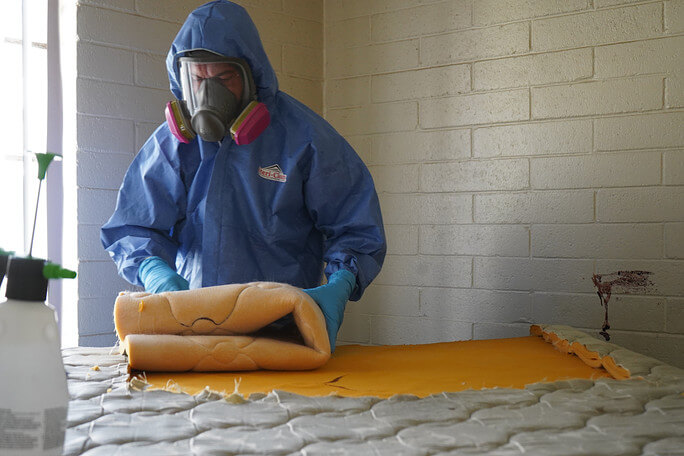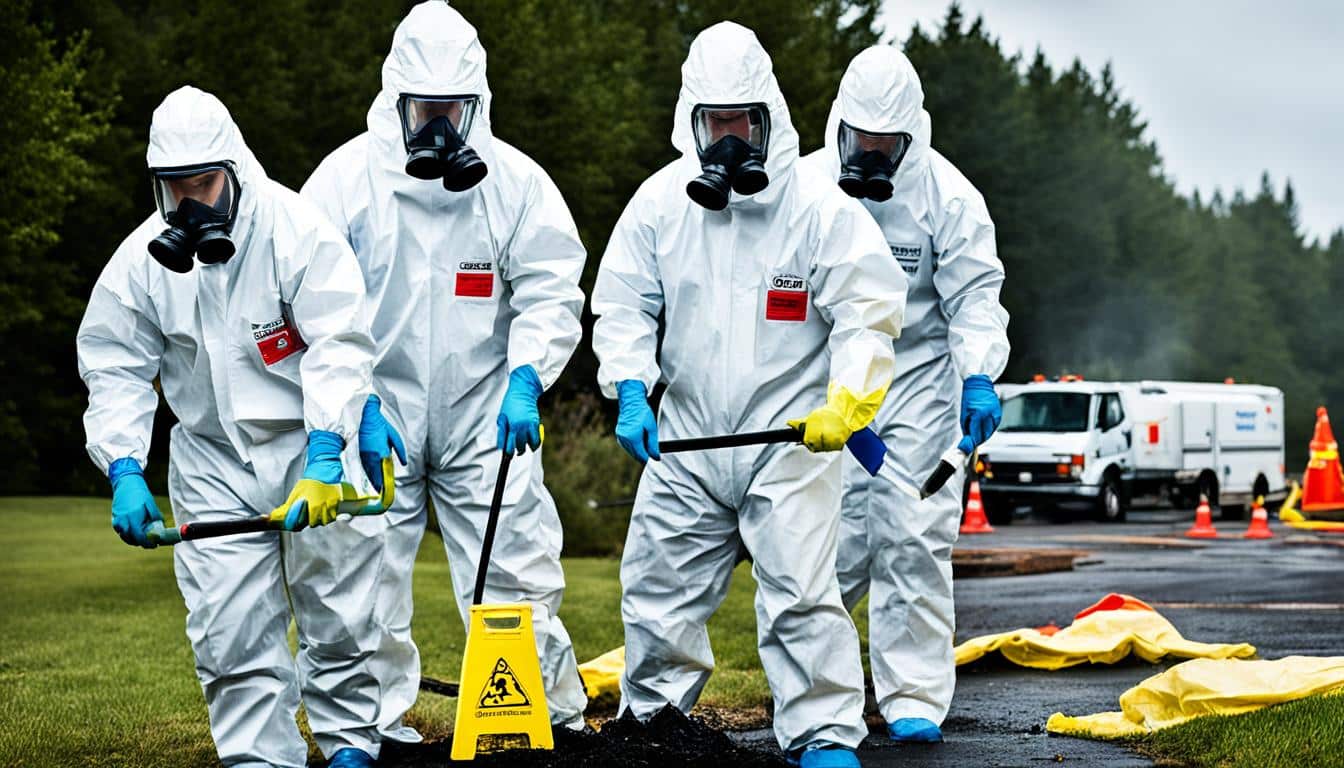Decomposition Death Clean Up: Specialized and Respectful Remediation
Decomposition Death Clean Up: Specialized and Respectful Remediation
Blog Article
Expert Biohazard Cleaning and Decontamination for Blood, Bodily Fluids, and Hazardous Materials
The potential wellness risks linked with exposure to biohazards emphasize the essential need for thorough handling and complete clean-up. As we browse the intricate landscape of biohazard clean-up, understanding the subtleties of laws, compliance, and the customized devices at play becomes vital in making certain a thorough and risk-free purification process.
Health And Wellness Threats of Biohazard Direct Exposure
Exposure to biohazards positions substantial health risks that can lead to extreme consequences for neighborhoods and people alike. Biohazards incorporate a vast array of biological compounds, consisting of blood, physical liquids, mold, bacteria, viruses, and other potentially contagious products. When people enter call with these biohazards, whether via accidents, improper handling, or environmental exposure, they deal with the danger of contracting severe ailments or diseases.
One of the main health and wellness dangers connected with biohazard exposure is the transmission of contagious illness. Bloodborne microorganisms such as HIV, hepatitis B and C, and different germs can be existing in biohazardous materials, positioning a direct risk to human health and wellness. Inhaling airborne biohazards like mold and mildew spores or coming right into contact with contaminated surfaces can also lead to respiratory system concerns, allergic reactions, and other unfavorable health effects.
In addition, biohazard exposure can have long-term wellness ramifications, with some diseases showing up years after the preliminary get in touch with (Blood Cleanup). Consequently, it is important to focus on proper biohazard cleaning and purification to alleviate these health and wellness dangers and guarantee the safety of communities and individuals

Specialized Educating for Biohazard Cleanup
When it involves dealing with biohazard cleaning efficiently and safely, specialized training plays a basic role in making certain proper decontamination treatments are followed. Biohazard clean-up calls for specific understanding and abilities to effectively alleviate threats connected with bloodborne microorganisms, physical liquids, and dangerous materials. Specialists trained in biohazard clean-up go through rigorous direction on just how to securely handle, remove, and take care of biohazardous materials to stop contamination and exposure.
Specialized training for biohazard clean-up covers a variety of essential subjects, consisting of proper personal protective devices (PPE) usage, bloodborne virus recognition, purification techniques, and hazardous waste disposal protocols. People learnt biohazard clean-up are furnished with the needed knowledge to examine contamination levels, determine prospective dangers, and carry out proper clean-up procedures in compliance with regulatory criteria.
Constant training and education and learning are paramount in the area of biohazard cleaning to remain updated on the most up to date decontamination innovations, security protocols, and regulations. By purchasing specialized training, biohazard cleaning professionals can effectively respond to emergency situation clean-up circumstances and protect both public wellness and the atmosphere.
Significance of Proper Purification Methods
Utilizing proper purification strategies is vital in biohazard clean-up to effectively decrease and get rid of hazardous products health dangers. Effective purification not look these up only ensures the removal of visible traces of blood, physical liquids, and various other biohazards yet additionally targets undetectable pathogens that might pose significant health and wellness threats if not properly eliminated. By adhering to strict purification procedures, educated professionals can dramatically decrease the threat of exposure to hazardous microorganisms, infections, and germs that could cause infections or diseases.
Correct decontamination methods entail using specific tools and disinfectants that are especially developed to counteract biohazards effectively. Detailed cleaning and disinfection of contaminated areas are necessary to prevent the spread of microorganisms and make certain a secure setting for occupants. Furthermore, the right disposal of biohazardous waste adhering to purification procedures is important in protecting against contamination of other surfaces or individuals.

Devices and Tools for Safe Clean-up
When dealing with blood, bodily liquids, or dangerous products, biohazard cleaning specialists depend on specialized equipment to reduce direct exposure risks and extensively decontaminate the afflicted location. Furthermore, biohazard cleansing kits including anti-bacterials, absorptive products, and biohazard bags are used to safely get rid of and have of contaminated things.
Advanced cleaning tools like hospital-grade anti-bacterials, HEPA-filtered vacuum cleaners, and misting machines are utilized to disinfect surfaces and eliminate biohazards properly. Specialized equipment such as sharps containers and biohazard garbage disposal containers are utilized to safely handle sharp things and biohazardous waste materials. By utilizing the appropriate equipment and tools, biohazard cleaning specialists can make certain a detailed cleanup process that prioritizes security and decreases health risks for both workers and residents of the damaged space.
Regulations and Compliance in Biohazard Cleaning
Proper adherence to policies and compliance requirements is vital in biohazard cleansing to ensure the safety of both personnel and the setting. Federal government firms such as OSHA (Occupational Safety And Security and Wellness Administration) and the EPA (Environmental Security Company) have developed certain standards for biohazard cleaning procedures to decrease health dangers and environmental contamination. These guidelines cover a variety of elements consisting of the handling, transport, and disposal of biohazardous products, in addition to the required training and protective devices required for personnel involved in the my company cleanup procedure.
Biohazard cleansing business should stay current with these laws to assure that their operations meet the called for safety and security criteria. Failure to abide by these regulations can cause extreme repercussions, including fines, lawsuit, and endangering the wellness of people and the atmosphere. By following strict laws and conformity steps, biohazard cleansing firms can properly alleviate risks and ensure a secure and comprehensive cleanup procedure for all celebrations involved.
Final Thought
In final thought, biohazard cleansing and decontamination call for specific training, correct methods, and adherence to laws. Direct exposure to blood, bodily liquids, and unsafe products poses considerable health threats, making it important to use the ideal equipment and devices for secure clean-up. By following stringent methods and standards, experts can effectively alleviate the threats associated with biohazard direct exposure and guarantee the safety and security of both themselves and others.
As we navigate the complex landscape of biohazard cleanup, comprehending the subtleties of policies, compliance, and the customized equipment at play ends up being crucial in guaranteeing a risk-free and thorough decontamination process. (Blood Cleanup)
When it comes to managing biohazard cleaning efficiently and safely, specialized training plays an essential duty in his explanation ensuring appropriate purification treatments are followed.Utilizing appropriate purification methods is critical in biohazard cleanup to effectively decrease and remove hazardous products health threats. Additionally, biohazard cleansing packages having anti-bacterials, absorbing products, and biohazard bags are made use of to securely consist of and get rid of of polluted products.
Government agencies such as OSHA (Occupational Safety And Security and Wellness Management) and the EPA (Environmental Security Agency) have developed certain guidelines for biohazard clean-up procedures to minimize wellness threats and environmental contamination.
Report this page